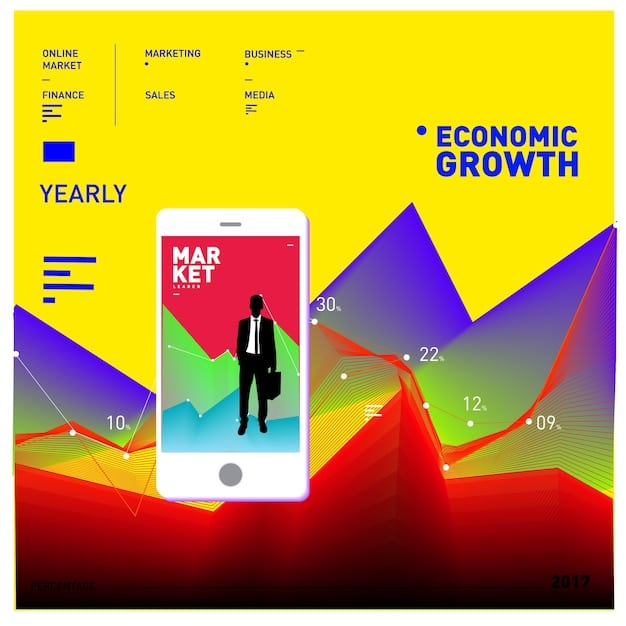Maximize E-commerce Profits 2025: Pricing Strategies Guide

Optimizing product pricing in e-commerce for 2025 is paramount for maximizing profits, requiring a nuanced understanding of market dynamics, customer behavior, and competitive landscapes to set effective, data-driven pricing strategies that enhance revenue and sustain growth.
In the dynamic realm of online retail, mastering your pricing strategy is not merely an option—it’s a fundamental necessity. This comprehensive guide, Maximize Your E-commerce Profits: A Guide to Optimizing Product Pricing Strategies for 2025, delves into the essential nuances of effective pricing, offering actionable insights to boost your bottom line next year and beyond.
Understanding the E-commerce Pricing Landscape of 2025
The e-commerce landscape is in perpetual flux, influenced by technological advancements, shifting consumer behaviors, and evolving economic conditions. For 2025, several key trends are poised to redefine how businesses approach pricing. Consumers are increasingly sophisticated, armed with more information and expecting greater transparency, value, and personalization. This necessitates a move beyond static pricing models toward dynamic, adaptable strategies that resonate with contemporary buying habits.
Furthermore, the competitive intensity continues to escalate, with new entrants and established players vying for market share. This environment makes differentiating your offering through smart pricing, rather than just product features, a critical success factor. Businesses must leverage data-driven insights to respond swiftly to market changes, ensuring their pricing remains competitive while simultaneously optimizing for profitability. The goal is to find the sweet spot where perceived value aligns with profitability, fostering both customer loyalty and sustainable growth.
The Shift Towards Dynamic and Personalized Pricing
Traditional fixed pricing, while simple, often fails to capture the full potential of market demand. Dynamic pricing, where prices fluctuate based on real-time factors, is gaining significant traction. This approach allows businesses to adapt to varying demand levels, inventory changes, and even individual customer segments, maximizing revenue opportunities.
- Real-time adjustments: Prices can change based on current demand, time of day, or stock levels.
- Algorithmic precision: Advanced algorithms analyze vast datasets to determine optimal prices.
- Competitive intelligence: Automated tools monitor competitor prices, enabling quick responses.
Personalized pricing takes this a step further, tailoring prices to individual customers based on their browsing history, past purchases, or loyalty status. While controversial if not handled transparently, when executed ethically, it can enhance customer perceived value and encourage conversions. The key is to convey the value proposition clearly, making the customer feel they are receiving a special offer rather than being unfairly targeted. Ethical considerations and customer trust must always be at the forefront when implementing such strategies.
The Role of Data Analytics in Modern Pricing
Data is the lifeblood of effective pricing in 2025. Without robust data analytics, businesses are essentially guessing at their pricing decisions. Comprehensive analysis of sales data, customer demographics, website traffic, and competitor actions provides an invaluable foundation for strategic pricing. Tools that offer predictive analytics can forecast demand and identify pricing opportunities before they become obvious to competitors.
Investment in analytics platforms capable of handling large volumes of diverse data is no longer a luxury but a fundamental requirement. These platforms can identify patterns, uncover hidden correlations, and even simulate the impact of different pricing scenarios. By transforming raw data into actionable insights, e-commerce businesses can make informed decisions that drive profitability and maintain a competitive edge in a saturated market.
In summary, 2025 demands a proactive, data-centric approach to pricing. Businesses that embrace dynamic, personalized, and analytically informed strategies will be best positioned to thrive amidst increasing competition and evolving consumer expectations. The foundational shift from intuition to data-driven precision is non-negotiable for anyone looking to maximize their e-commerce profits.
Key Pricing Strategies to Consider for 2025 E-commerce
Selecting the right pricing strategy is pivotal for sustained e-commerce success. There isn’t a one-size-fits-all solution; rather, the optimal strategy depends on your products, target audience, competitive landscape, and business objectives. For 2025, a blend of traditional wisdom and innovative digital approaches will likely yield the best results.
Understanding the nuances of each strategy allows businesses to apply them strategically, sometimes even combining elements from different models to create a unique and effective pricing structure. The goal is to maximize perceived value for the customer while ensuring healthy profit margins for the business.

Value-Based Pricing: Aligning Price with Perceived Customer Worth
Value-based pricing centers on what a customer believes a product is worth, rather than solely on production costs or competitor prices. This strategy requires a deep understanding of your target market’s needs, pain points, and willingness to pay. By focusing on the benefits and solutions your product offers, you can justify a premium price if the perceived value is high.
- Customer surveys: Gather data directly from your audience about what they value.
- Benefit articulation: Clearly communicate the unique advantages and solutions your product provides.
- Segmentation: Price differently for segments that derive more value from your offering.
Implementing value-based pricing successfully means investing in marketing that effectively communicates your product’s unique selling propositions. It also involves ongoing research to ensure that your perceived value remains aligned with evolving customer expectations. This approach helps build strong brand loyalty and can lead to higher profit margins compared to purely cost-plus or competitor-based pricing.
Competitive Pricing: Staying Agile in a Crowded Market
In highly competitive markets, setting prices relative to your competitors is a common and often necessary strategy. This doesn’t mean simply undercutting them, which can lead to a race to the bottom, but rather positioning your prices strategically. This might involve matching prices, slightly underpricing to gain market share, or even overpricing if your brand offers superior value or unique features.
Effective competitive pricing relies heavily on robust competitor analysis tools that provide real-time data on their pricing changes, promotions, and product bundles. This enables rapid adjustments to your own pricing, ensuring you remain competitive without sacrificing profitability.
However, relying solely on competitive pricing can be risky. It can commoditize your product and make it difficult to build a distinct brand identity. The best approach often involves using competitive intelligence as one input among many, rather than the sole determinant of your pricing strategy. This allows for a more nuanced approach that balances market position with value proposition.
Cost-Plus Pricing: The Foundation (and Its Limitations)
Cost-plus pricing is one of the simplest methods, involving calculating the total cost of producing or acquiring a product and then adding a fixed percentage markup for profit. While straightforward and easy to implement, its primary limitation is that it ignores market demand, competitor pricing, and perceived customer value.
For example, if your costs are high but market demand is low, cost-plus pricing might result in prices that customers are unwilling to pay. Conversely, if your costs are low for a high-demand product, you might leave money on the table. While it can serve as a baseline, businesses should augment cost-plus pricing with other strategies that reflect market realities and customer willingness to pay to avoid underpricing or overpricing.
Ultimately, a successful e-commerce business in 2025 will likely employ a strategic mix of these methods, adapting their approach based on specific product lines, market segments, and overarching business goals. The key is agility and a willingness to analyze and adjust.
Advanced Pricing Tactics for E-commerce Growth
Beyond the core strategies, several advanced tactics can significantly enhance your e-commerce pricing efficiency and profitability. These methods are designed to influence customer perception, encourage higher spending, and optimize sales funnels. Often, these tactics work best when integrated into an overarching data-driven pricing framework.
Implementing these advanced tactics requires careful testing and continuous monitoring to understand their impact on both sales volume and profit margins. What works for one product or customer segment might not work for another, emphasizing the need for flexibility.
Psychological Pricing: Leveraging Perception for Profit
Psychological pricing taps into consumer emotions and perceptions to influence buying decisions. This isn’t about deception, but rather about presenting prices in a way that feels more appealing or valuable. Common examples include using prices that end in $.99 (e.g., $9.99 instead of $10.00) to make them appear significantly cheaper, or “charm pricing.”
- Charm pricing (e.g., $XX.99): Creates the perception of a lower price and signals a bargain.
- Price anchoring: Presenting a higher-priced item first to make subsequent items seem more affordable.
- Bundle pricing: Offering multiple products together at a slightly reduced price to increase perceived value and average order value.
Other tactics include offering tiered pricing, where different versions of a product or service are offered at increasing price points to cater to various budgeting needs, or framing prices to emphasize savings rather than cost. The effectiveness of psychological pricing often depends on cultural factors and target demographics, making A/B testing crucial for optimization.
Subscription Models and Recurring Revenue
Subscription models, where customers pay a recurring fee for access to products or services, are a powerful way to build stable, predictable revenue streams. This model is particularly effective for consumable goods, digital content, or membership-based services. The predictable income allows for better financial planning and investment in customer retention.
While the initial conversion might seem harder with a recurring commitment, the long-term customer lifetime value (CLV) can significantly outweigh that of one-time purchases. Key to success is continually delivering value and maintaining customer engagement to minimize churn. Offering different tiers within your subscription, such as basic, premium, and deluxe, can also cater to various customer needs and budget levels, further expanding your market reach.
Freemium and Decoy Pricing: Guiding Customer Choices
Freemium models offer a basic version of a product or service for free, with premium features or expanded access available for a fee. This allows potential customers to experience the value firsthand, reducing friction to adoption and fostering a qualified lead pipeline. Conversion rates from free to paid tiers are crucial metrics to track here.
Decoy pricing involves adding a third pricing option that is intentionally less attractive to make another option seem more appealing. For instance, if you have options A ($10) and B ($20), introducing a “decoy” option C ($19, but with fewer features than B) can make option B look like a much better deal, nudging customers towards the higher-priced, more profitable choice. These tactics subtly guide customers towards desirable purchasing paths.
These advanced pricing tactics are not standalone solutions but integral components of a sophisticated pricing strategy. When applied thoughtfully and ethically, they can significantly contribute to an e-commerce business’s ability to drive growth and maximize profitability in 2025.
Leveraging Technology for Pricing Optimization in 2025
In the digital age, technology is not just an enabler but a fundamental driver of pricing excellence. Manual pricing adjustments are simply insufficient to keep pace with dynamic markets and vast product catalogs. Automation, artificial intelligence (AI), and machine learning (ML) are transforming how e-commerce businesses set and manage their prices, leading to unprecedented levels of optimization and efficiency.
Embracing these technological advancements allows businesses to gain a significant competitive advantage by responding instantaneously to market shifts, predicting demand, and personalizing offers at scale. The right tools can turn complex pricing challenges into manageable, data-driven opportunities.
AI and Machine Learning in Dynamic Pricing
AI and machine learning algorithms are at the forefront of dynamic pricing. These sophisticated systems can analyze millions of data points—including competitor prices, historical sales, website traffic, time of day, weather patterns, and even social media sentiment—to determine optimal prices in real-time. They can detect subtle patterns and correlations that human analysts would miss, leading to incredibly precise pricing adjustments.
- Predictive analytics: Forecast demand and optimize inventory levels to prevent stockouts or overstocking.
- Competitor monitoring: Automatically track competitor price changes and adjust your own prices to stay competitive.
- Personalized offers: Deliver tailored pricing based on individual customer data and behavior.
The beauty of AI-powered pricing is its ability to learn and improve over time. As more data is fed into the system, the algorithms become more accurate in their predictions and recommendations, continuously fine-tuning pricing strategies for maximum profit. This ensures that a business is always operating at its peak pricing efficiency.
Automated Pricing Software and Tools
For businesses looking to implement dynamic pricing without a dedicated team of data scientists, automated pricing software offers a viable solution. These platforms integrate with your e-commerce store and provide a dashboard for setting pricing rules, monitoring performance, and automating price changes.
Key features often include competitive repricing, where the software automatically adjusts your prices based on competitor actions, and rule-based pricing, allowing you to set specific conditions for price changes (e.g., if stock drops below a certain level, increase price). Some tools also offer elasticity modeling, helping you understand how changes in price affect demand.
The benefits of such tools extend beyond efficiency; they reduce human error, free up valuable staff time, and ensure that pricing strategies are executed consistently across your entire product line. Choosing the right software involves evaluating its compatibility with your existing systems, its customization options, and its ability to scale with your business needs.
Data Integration and Analytics Platforms
The effectiveness of AI and automated tools hinges on the quality and accessibility of data. Comprehensive data integration platforms that centralize data from various sources—CRM, ERP, web analytics, marketing automation, etc.—are crucial. These platforms provide a unified view of your business performance, allowing for more holistic and informed pricing decisions.
Furthermore, robust analytics dashboards are essential for visualizing data, identifying trends, and measuring the impact of pricing strategies. They allow businesses to track key performance indicators (KPIs) like average order value, conversion rates, profit margins, and customer lifetime value, providing the insights needed for continuous optimization. The synergy between strong data infrastructure and advanced technological tools is what sets truly successful e-commerce businesses apart in 2025.
Implementing and Optimizing Your Pricing Strategy
Developing a robust pricing strategy is only half the battle; effective implementation and continuous optimization are equally critical. A static strategy in a dynamic market is a recipe for stagnation. Businesses must adopt an agile approach, treating pricing as an ongoing experiment rather than a one-time decision.
This involves setting clear objectives, conducting thorough testing, and establishing a feedback loop that informs future adjustments. The goal is not just to set a price, but to manage and evolve it for sustained profitability and market relevance.
Testing and A/B Split Testing for Pricing
One of the most effective ways to refine your pricing strategy is through rigorous testing, particularly A/B split testing. This involves presenting different price points or pricing models to separate segments of your audience to see which performs better in terms of conversions, revenue, or profit margins. A/B testing allows you to make data-backed decisions instead of relying on intuition.
- Hypothesis formulation: Clearly define what you expect to happen with a price change.
- Controlled experiments: Isolate variables to ensure accurate results.
- Statistical significance: Ensure enough data is collected to draw reliable conclusions.
It’s important to test one variable at a time (e.g., only the price, not the product description simultaneously) to accurately attribute the outcome. Monitor not only conversion rates but also average order value, gross profit, and overall sales volume. The iterative nature of A/B testing means constant improvement and fine-tuning.
Monitoring Key Performance Indicators (KPIs)
Effective pricing management requires meticulous tracking of relevant KPIs. These metrics provide insights into the health of your pricing strategy and identify areas for improvement. Beyond top-line revenue, focus on indicators that reflect profitability and customer behavior:
Common KPIs include:
- Conversion Rate: The percentage of visitors who make a purchase.
- Average Order Value (AOV): The average amount spent per customer order.
- Gross Profit Margin: The percentage of revenue left after deducting the cost of goods sold.
- Customer Lifetime Value (CLV): The total revenue expected from a customer throughout their relationship with your business.
- Price Elasticity of Demand: How sensitive demand is to changes in price.
Regularly reviewing these KPIs against your business goals helps validate your pricing decisions and signals when adjustments are needed. Dashboards that provide real-time visibility into these metrics are invaluable for keeping a pulse on your pricing performance.
Responding to Market Changes and Competition
The e-commerce market is constantly evolving, influenced by new competitors, economic shifts, supply chain disruptions, and changing consumer preferences. A flexible pricing strategy is essential for adapting to these external factors. This means having the tools and processes in place to quickly adjust prices in response to market signals. For instance, if a key competitor drops their price significantly, you need to be able to react without undermining your own profitability.
Continuous market research, competitor analysis, and a willingness to iterate are hallmarks of successful e-commerce businesses in 2025. This adaptability not only mitigates risks but also uncovers new opportunities for strategic pricing and competitive advantage.
Common Pitfalls and How to Avoid Them
While the pursuit of optimal pricing strategies can yield significant returns, several common pitfalls can derail your efforts. Being aware of these traps and proactively implementing measures to avoid them is crucial for long-term success. The biggest mistakes often stem from a lack of data, a disregard for customer perception, or an inability to adapt to market dynamics.
Navigating these challenges requires a balanced approach, combining analytical rigor with an understanding of human psychology, and always prioritizing the customer experience.
The Race to the Bottom: Why Undercutting Isn’t Always the Answer
One of the most tempting but often destructive pitfalls is engaging in a “race to the bottom” – continuously lowering prices to undercut competitors. While it might lead to short-term sales boosts, it invariably erodes profit margins, devalues your brand, and can attract undesirable customer segments focused solely on price rather than value. This outcome makes it exceedingly difficult to raise prices later, even if your supply costs increase or you add more value.
Instead of focusing solely on the lowest price, differentiate through superior product quality, exceptional customer service, unique features, or strong brand storytelling. Compete on value, not just price. This approach builds a more sustainable business model and fosters customer loyalty that extends beyond mere cost considerations.
Ignoring Customer Perception and Value Proposition
Pricing decisions made in isolation, without considering how customers perceive your product’s value, are bound to fail. Simply setting prices based on costs or competitor analysis misses the crucial element of perceived worth. If customers don’t see the value, even a low price might be deemed too high. Conversely, if they perceive immense value, they might be willing to pay a premium.
This pitfall highlights the importance of understanding your target audience, conducting market research, and clearly articulating your product’s unique selling proposition. Ensure your pricing aligns with the benefits and solutions you offer, and communicate that value effectively through your marketing and branding. Consistent messaging about your value proposition helps reinforce your price point.
Lack of Data-Driven Decision Making
Relying on gut feelings, anecdotal evidence, or outdated information for pricing decisions is a recipe for missed opportunities and potential losses. Without robust data analytics, businesses are essentially operating blind, unable to accurately assess the impact of their pricing strategies or identify areas for improvement. This leads to sub-optimal pricing that can either leave money on the table or deter potential customers.
To avoid this, invest in analytics tools and cultivate a data-driven culture within your organization. Collect and analyze sales data, customer behavior, market trends, and competitor actions. Use this data to inform every pricing decision, from initial product launch to ongoing price adjustments. Regular reporting and performance reviews are essential for making informed, strategic pricing choices.
By actively working to avoid these common pitfalls, e-commerce businesses can approach pricing with greater confidence and strategic foresight. This proactive stance ensures that pricing not only drives sales but also builds long-term profitability and a strong market position.
Future-Proofing Your Pricing Strategy for Beyond 2025
As we look towards 2025 and beyond, the pace of change in e-commerce shows no signs of slowing down. Future-proofing your pricing strategy means building resilience, adaptability, and an ongoing commitment to innovation into your core operations. It’s about anticipating emerging trends and building structures that can evolve with them, rather than simply reacting to past shifts.
The businesses that thrive will be those that embrace continuous learning, invest in cutting-edge technology, and prioritize a deep understanding of their customers in an increasingly personalized and AI-driven marketplace.
Anticipating Emerging Trends (AI, Personalization, Sustainability)
Several key trends are set to shape the future of e-commerce pricing. Artificial intelligence will continue to become more sophisticated, offering even deeper insights and more precise automation in pricing. Hyper-personalization, driven by advanced AI, will increasingly allow for highly individualized pricing, loyalty programs, and promotional offers, demanding a nuanced ethical approach to maintain customer trust.
Sustainability is also moving from a niche concern to a mainstream expectation. Consumers are increasingly willing to pay a premium for ethically sourced, environmentally friendly products. Pricing strategies might need to reflect these values, potentially incorporating a “green premium” that aligns with customer values rather than just cost. Staying ahead of these trends requires continuous research and a willingness to experiment with new models and technologies.
Building a Flexible and Adaptive Pricing Framework
Rigid pricing models will struggle in the future. The ability to quickly pivot and adapt your pricing in response to new data, market shifts, or unforeseen disruptions will be paramount. This means moving away from annual price reviews to a more agile, potentially real-time, adjustment mechanism. Your internal systems should be capable of implementing changes swiftly across your entire product catalog.
An adaptive framework also includes contingency planning for various scenarios—like supply chain shocks or sudden competitor actions. This readiness ensures that your business can maintain profitability and market share even in volatile conditions. Continuous learning and iterative testing are key components of such a flexible framework, ensuring that any adjustments are data-driven and effectively contribute to your overall financial health.
The Perpetual Cycle of Optimization and Learning
Ultimately, future-proofing your pricing strategy is about embedding a culture of perpetual optimization and learning within your organization. Pricing isn’t a fixed destination but an ongoing journey of discovery and refinement. This involves regularly reviewing performance metrics, analyzing customer feedback, staying abreast of technological advancements, and critically evaluating the effectiveness of current strategies.
Encourage cross-functional collaboration between marketing, sales, product development, and finance teams to ensure a holistic approach to pricing. By fostering an environment where experimentation is embraced and valuable lessons are continually extracted from both successes and failures, your e-commerce business can confidently navigate the complexities of the future market and continue to maximize its profits well beyond 2025.
| Key Strategy | Brief Description |
|---|---|
| 📈 Dynamic Pricing | Adjusts prices in real-time based on demand, inventory, and market conditions for optimal revenue. |
| 💖 Value-Based Pricing | Sets prices based on perceived customer worth and benefits, not just costs. |
| 🤖 AI-Powered Optimization | Leverages AI/ML to analyze data, predict demand, and automate pricing decisions. |
| 🧪 A/B Testing | Compares different pricing models or points to identify the most effective for conversions and profit. |
Frequently Asked Questions About E-commerce Pricing
▼
Dynamic pricing involves adjusting product prices in real-time based on factors like demand, inventory levels, competitor pricing, and time of day. Its primary benefit is maximizing revenue by adapting to market fluctuations, ensuring products are priced optimally at any given moment. This agility can lead to increased sales and improved profit margins.
▼
A/B testing is critically important for pricing optimization as it allows businesses to experiment with different price points or models and measure their direct impact on customer behavior. By isolating variables, you can confidently determine which pricing strategies lead to higher conversion rates, average order values, and overall profitability, making decisions based on empirical data.
▼
Yes, AI and machine learning play a transformative role in pricing optimization. These technologies can analyze vast datasets, including historical sales, market trends, and competitor actions, to predict demand and recommend optimal prices with high precision. AI-driven systems continuously learn and adapt, allowing for dynamic pricing adjustments that human analysts simply cannot achieve efficiently.
▼
The “race to the bottom” refers to continuously lowering prices to undercut competitors, which can lead to significant risks. It squeezes profit margins, devalues your brand’s perceived worth, and attracts customers who prioritize price over value, leading to lower customer loyalty. This strategy is unsustainable and makes it difficult to raise prices in the future, harming long-term profitability.
▼
Customer perception is central to effective pricing. The perceived value of a product, rather than just its cost, significantly influences what customers are willing to pay. Ignoring this can lead to mispricing. Successful strategies align price with perceived benefits, clearly communicate value, and consider psychological pricing tactics to enhance how customers view the worth of your offerings.
Conclusion: The Strategic Imperative of Pricing for 2025
As we navigate toward 2025, it’s clear that effective pricing is more than just setting a number; it’s a strategic imperative that directly impacts your e-commerce profitability and sustainability. The landscape demands a nuanced approach—one that integrates data-driven insights with a deep understanding of customer behavior and market dynamics. By embracing dynamic strategies, leveraging advanced technology like AI, and fostering a culture of continuous optimization, businesses can transform their pricing from a mere administrative task into a powerful engine for growth. The future belongs to those who view pricing as an ongoing, adaptive process, crucial for realizing maximum profits and securing a competitive edge in the evolving digital marketplace.





